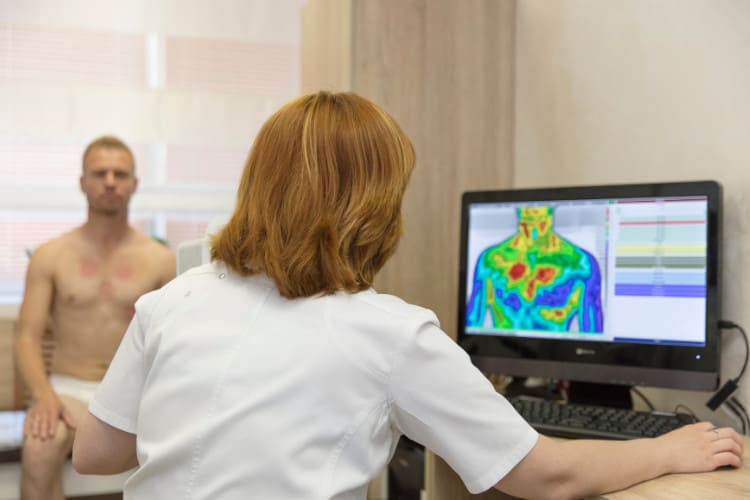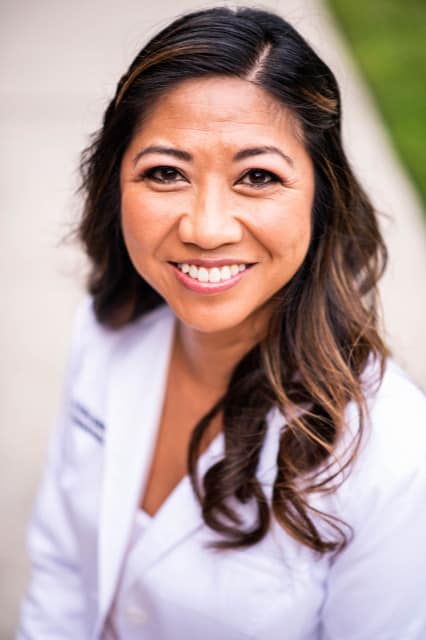Medical Thermography: Benefits and Uses

What is medical thermography, and how can it improve your health? We talked with Dr. Jayne Dabu of Lotus Acupuncture to learn all about this innovative health technique.
What Is Medical Thermography?
Thermography uses infrared thermal imaging to detect heat patterns. Professionals use thermographic images in many different industries, including plumbing and engineering. And medical thermography might be especially important as an early detection tool for several conditions, including breast cancer.
But is the use of thermal imaging for early disease detection wishful thinking, or one with medical benefits? According to Dr. Jayne Dabu, when used in correlation with other forms of treatments, it can help people discover specific ailments after viewing their imaging. “It’s a great preventative source for patients,” she says. “It can detect the blood flow patterns before they show up as tissue changes on an MRI.”
Medical Thermography Uses

Many of the articles around medical thermography revolve around its potential uses as a breast cancer screening tool without radiation. But even though it can detect blood flow in the breast tissue, it can have many other uses, too.
“Besides breast irregularities, it can detect things with the teeth, sinuses, thyroid, or anything in the neck and tonsils,” says Dr. Dabu. “It can detect a lot of lymph congestion in the armpits or heat around the organs, especially the liver, stomach, spleen, and colon.”
“It’s using digital infrared thermal imaging (DITI) It’s a camera that detects heat patterns and blood flow patterns,” she says. “There are different colors when you’re looking, ranging from no color to white. If you can see no color, blue, or purple, there’s not a lot of blood flow. At the other extreme, bright red is really hot. White is super hot. You can see those patterns throughout the body. It gives a visual of where the blood flow patterns.“
Breast Thermography and Cancer Detection
But while infrared thermal imaging can show blood flow of specific parts of the body, it is meant to be used in conjunction with traditional mammograms, NOT as a substitute for them. So while it might help detect early breast cancer, it’s not the only diagnostic tool.
Noticing changes in the blood flow of these regions from one thermogram screening to the next can often alert patients to get additional checkups with their doctors practicing traditional Western medicine.
One of Dr. Dabu’s patients had a mammogram in July, which didn’t detect any form of cancer. She still didn’t feel quite right, so she had a thermogram in January. At that appointment, the thermogram detected something suspicious. She then had another mammogram, which revealed a mass. The thermogram was instrumental in the early detection of her patient’s cancer.
“This is never a replacement, for sure,” says Dr. Dabu. “This is a tool for you to see if there are already patterns. Sometimes women want to double-check if they don’t see something on the mammogram, but start working on that now. You never want to use this as a replacement.”
Are There Risks to Medical Thermography?
Since medical thermography consists of infrared images and analysis of them, there’s no risk or radiation involved in the process.
When you go to get a thermogram, expect to disrobe (except for your underwear), stand up, and face different directions as the technician takes photos to detect blood flow through your tissue. It’s an extremely simple procedure.
Where Can You Get a Medical Thermogram?
The thermography industry is highly regulated by the American College of Thermography. From their site, you can find locations near you with technicians and MDs who have been trained in interpreting the data. All of the thermography centers must meet certain criteria, including a private temperature-controlled room with no windows.
After you receive your images, a team of 12-18 MDs will provide an analysis and an action report with lifestyle recommendations. The process costs about $475 for a full-body scan, and often if they detect any areas with unusual blood flow, a patient will follow up with more focused scans on those specific regions every few months.
Who Would Benefit From Medical Thermography?

According to Dr. Dabu, everybody can benefit from this infrared imaging because it helps show you how to treat your body.
The infrared and thermal imaging gives people an idea of some of the things going on in their body below the surface. In many cases, it can help them identify and make healthy lifestyle changes before certain areas become problematic.
“They can tell on the vertebrae the possible autoimmune issues,” says Dr. Dabu, “even before they show up on your blood test.”
Is Thermography FDA-Approved?
While the FDA has issued warnings about the use of thermal imaging as “an effective screening tool,” it has approved this process as an adjunctive tool. “This means it’s for use alongside primary tests like mammography or ultrasound,” says Dr. Dabu. “No breast test is perfect. Patients should still have yearly breast exams, based on risk factors and when providers feel it necessary.” But when used as an adjunctive tool, it can be a powerful way for patients to have a more complete picture of their health.
Should You Get a Medical Thermogram?
If your budget permits, a medical thermogram could be a helpful addition to other medical diagnostic tests. Taking a holistic approach to these types of treatment can go a long way towards promoting health and wellness for years to come.
If you want to learn more about thermography, you can learn more from Dr. Dabu’s webinar. And if you’re in Virginia and interested in getting a thermogram, you can book one here.

Meet Dr. Jayne Dabu
Jayne Dabu, DAOM, L.Ac. founded Lotus Acupuncture & Holistic Clinic in Virginia Beach, Virginia, in November of 2011 with a desire to provide the best comprehensive and quality health care available in Hampton Roads.
Dr. Dabu is a Nationally Board Certified Licensed Acupuncturist with a Diplomate in Acupuncture by the National Certification Commission for Acupuncture and Oriental Medicine (NCCAOM – www.nccaom.org).
As a cancer survivor, she deeply understands the continuing journey patients must travel to heal their physical, emotional, and spiritual being.
Jayne is passionate about her patients’ health and wellness, which shows in her commitment, compassion, discipline, and love. Jayne’s loyal commitment to educating her patients empowers and enables them to transform their health, thus allowing them to make healthy choices in their lives and make a difference in the lives of the people THEY touch.





